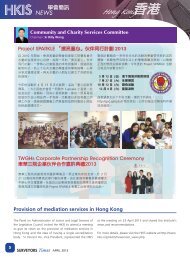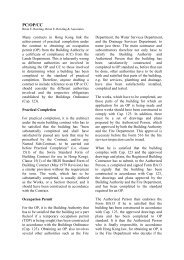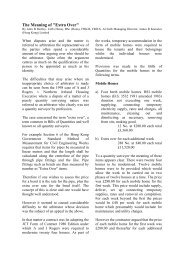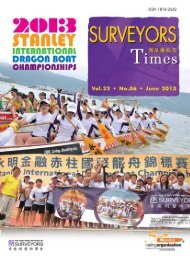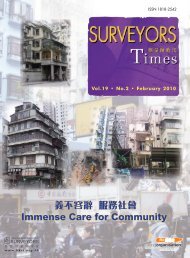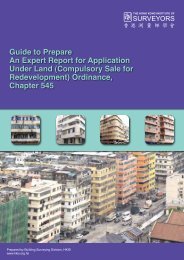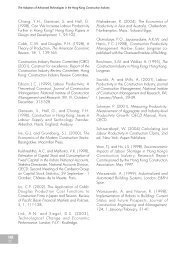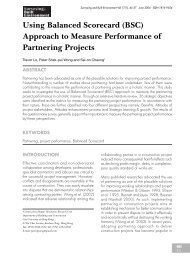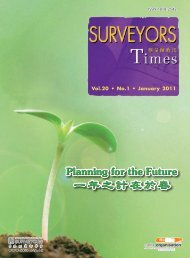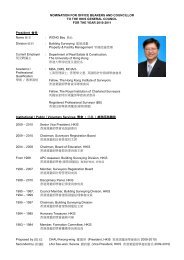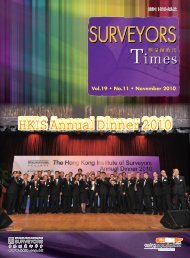Surveying & Built Environment Vol. 22 Issue 1 (December 2012)
Surveying & Built Environment Vol. 22 Issue 1 (December 2012)
Surveying & Built Environment Vol. 22 Issue 1 (December 2012)
Create successful ePaper yourself
Turn your PDF publications into a flip-book with our unique Google optimized e-Paper software.
five traditional methods of valuation,<br />
the Market Comparison Approach is<br />
the most accurate; Cost Approach the<br />
least accurate. In turn, surveyors in<br />
developed economies typically rely<br />
on the Market Comparison more often<br />
than other methods of valuation. In<br />
Hong Kong, for example, market based<br />
traditional econometric models and,<br />
more recently, artificial neural networks<br />
are the most common approaches<br />
used by practitioners and property<br />
researchers (Yip and Lee, 2008).<br />
The situation is rather different in<br />
Ghana. Valuers-in-training normally are<br />
schooled in using the Cost Method of<br />
valuation (Obeng-Odoom and Ameyaw,<br />
2011). Therefore, the majority of reports<br />
prepared for the qualifying examination<br />
for professional membership of the<br />
Ghana Institution of Surveyors draw<br />
on that approach (Ezaah, 2007).<br />
Apart from rating valuation which,<br />
according to section 96 (9) of the Local<br />
Government Act, 462, valuers are<br />
obliged to use the Cost Method, in all<br />
other cases, such as estimating value<br />
for the purpose of sale, forced sale,<br />
insurance, and mortgage, valuers are<br />
at liberty to choose any other valuation<br />
method. However, valuers in Ghana<br />
adopt the Cost Approach for almost all<br />
valuation tasks.<br />
This situation stands in stark contrast<br />
with the situation in Australia, a country<br />
from which Ghana has benefitted<br />
considerably - in terms of valuation 7 .<br />
In Australia, there is an overwhelming<br />
reliance on direct market approaches<br />
to valuation and a positive correlation<br />
<strong>Surveying</strong> and <strong>Built</strong> <strong>Environment</strong> <strong>Vol</strong> <strong>22</strong>, 37-60 Nov <strong>2012</strong> ISSN 1816-9554<br />
between academic qualifications<br />
and valuation methodology. That<br />
is, as valuers advance in academic<br />
qualifications, there is a high tendency<br />
to abandon simple market approaches<br />
to sophisticated market approaches such<br />
as discounted cash flow methods. Also,<br />
as valuers advance in experience, more<br />
simple market approaches are replaced<br />
with discounted cash flow techniques<br />
(Boyd, 1995). None of these is the<br />
case in Ghana where the Cost Method<br />
of valuation is the dominant method,<br />
regardless of education or experience.<br />
In Ghana, the Cost Method ‘is<br />
king’. Sometimes referred to as the<br />
Contractor’s Test, it is based on the<br />
philosophy that the informed purchaser<br />
would pay no more than the cost of<br />
producing a substitute property with the<br />
same satisfaction as the property which<br />
is the subject of valuation (Johnson et<br />
al., 2000). When using this method,<br />
typically Ghanaian valuers go through<br />
three stages. First, they estimate the<br />
gross replacement cost. Next, they<br />
ascertain depreciation. Then, they<br />
assess the value of the subject land,<br />
which is given by two simple equations:<br />
GRC – D =<br />
NRC ………………………Equation 1<br />
NRC + LV =<br />
PV …………………………Equation 2<br />
Where:<br />
GRC is Gross Replacement Value;<br />
D is Depreciation;<br />
NRC is Net Replacement Value;<br />
LV is Land Value; and<br />
7 For example, it was the Australian valuer, John Francis Murray who was commissioned by the UN in<br />
1958 to advise the Ghanaian government on the problems of using the number of rooms and windows as<br />
a basis for rating, and on what alternatives were available. The current system of rating in Ghana is based<br />
on Murray’s ideas (see a detailed history in Adem and Kwarteng, 2007, pp.40-41).<br />
SBE<br />
49



